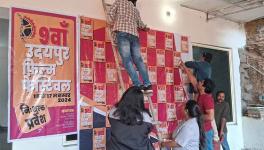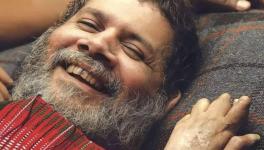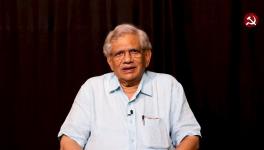Is Kerala Really a “Killing Field”? Numbers Tell a Different Story
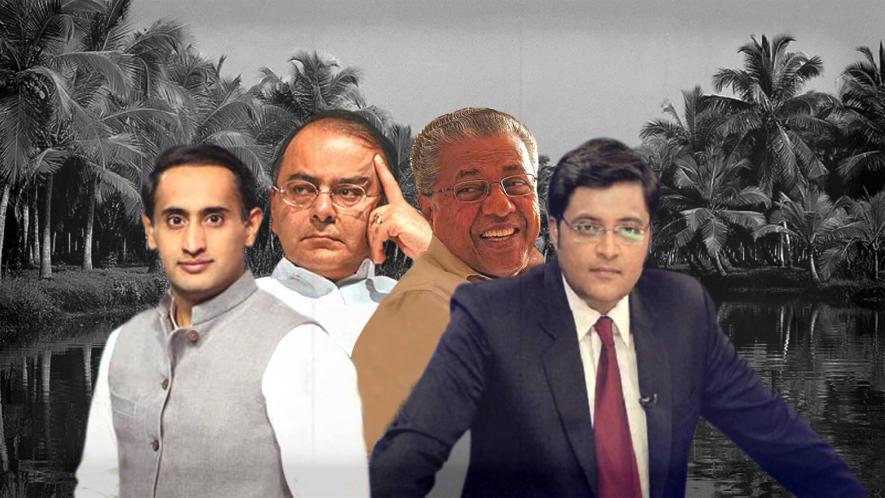
The recent weeks have seen a raucous campaign against the state of Kerala by the RSS-BJP. The Hindutva outfits have for long claimed that Kerala is a “violent” place where people are wantonly slaughtered. There have been many accounts of concerted campaigns in various states of North India where videos depicting random instances of violence happening elsewhere in the country are being portrayed as incidents of “Hindus being killed in Kerala”.
The campaign by Hindutva outfits reached a fever pitch in the recent days, with senior all India leaders of the RSS-BJP holding frequent press conferences to play up the issue. Right-wing journalist Rahul Kanwal toured Kerala to run prime time shows on what his channel described as Kerala’s “Killing Fields”. Union Finance Minister Arun Jaitley visited Thiruvananthapuram to meet the family of the RSS karyavahak who was killed on 29 July. BJP all India President Amit Shah is also apparently planning to hold a “Kerala March” in September.
Is Kerala really a “killing field” as the RSS-BJP would want us to believe?
Statistics from the National Crime Records Bureau tell us a different story altogether. The latest NCRB data set is available for the year 2015, and since at the very least there is no evidence of the law and order situation having worsened significantly since then, we use the same data in our analysis. Here we’ll be comparing some crucial parameters concerning violent crimes in Kerala and selected States which are ruled by the BJP today.
Kerala has the lowest murder rate in India
Kerala’s murder rate is the lowest in the country – 0.9 per one lakh population (Chart 1). The murder rate in Gujarat, which has been under BJP rule continuously for more than two decades now, is at 1.8, double that of Kerala. Other states which are ruled by BJP such as Maharashtra and Madhya Pradesh have far higher rates – 2.1 and 3 respectively.

Data on kidnapping and abduction (K&A) (Chart 2) show a similar pattern, with Kerala recording the lowest rates of the crime among all states – 0.8 per one lakh. Gujarat has a K&A rate of 3.4, Rajasthan has a rate of 7.5 and Madhya Pradesh, 8.8.
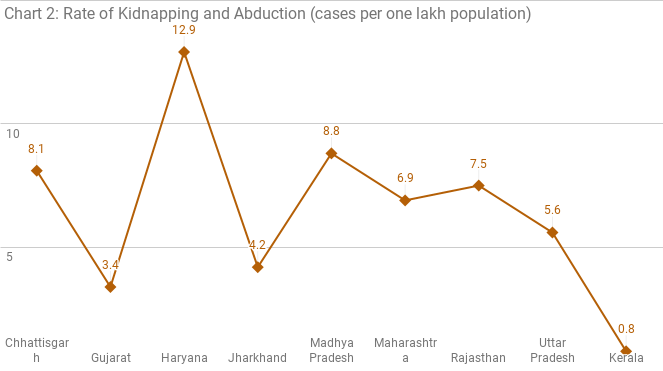
The rate of kidnapping and abduction of women to compel them for marriage (Chart 3) is at an alarmingly high 7.8 per one lakh in Haryana, while it is only slightly lower in Rajasthan, at 6.8. Uttar Pradesh, where the BJP came back to power in 2017, has an even higher rate, at 8.1.
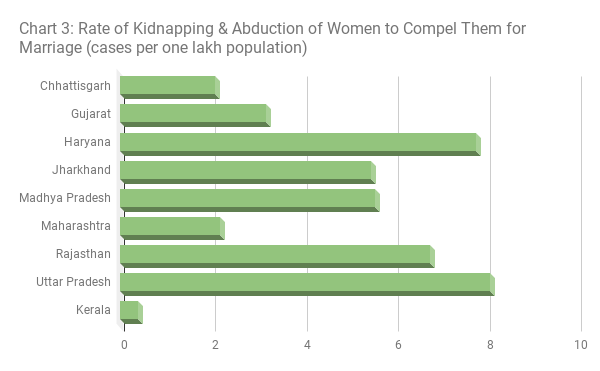
Kerala’s reputation as a State where different religious communities co-exist and thrive relatively peacefully is confirmed by the low number of reported communal riots (6 in 2015), while it was 45 in Gujarat, 80 in Maharashtra and 201 in Haryana (Chart 4).
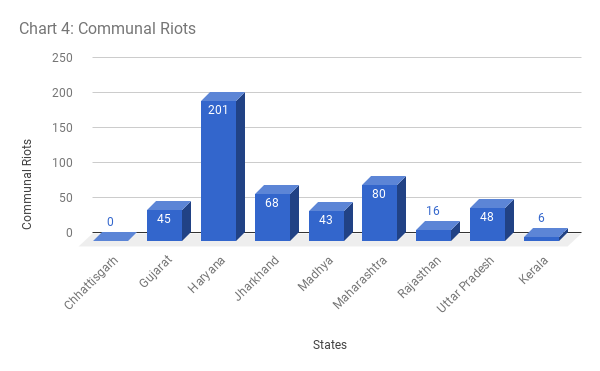
A similar pattern can be seen in the case of caste-related riots as well (Chart 5), with Kerala recording zero caste-related riots in 2015. Gujarat, Maharashtra and Jharkhand recorded 141, 204 and 252 cases of caste-related riots. . (Of course, Rajasthan showing zero caste riots in 2015 is a clear case of under-reporting. A simple web search throws up several instances of caste riots in Rajasthan that year, some of which resulted in the deaths of several people.)
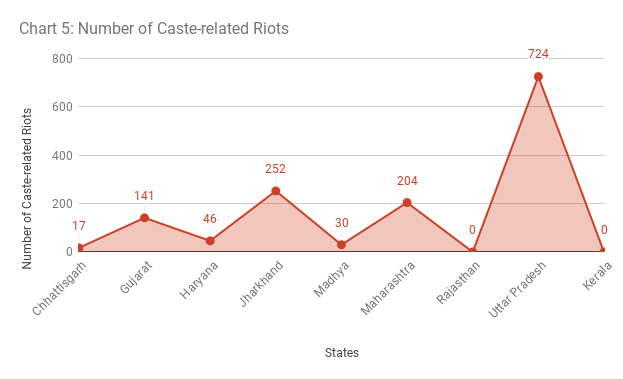
The number of riot incidents between Dalits or Adivasis on the one side and those from other communities on the other were roughly half the total number of caste-related riots in Gujarat and Maharashtra (Chart 6). Uttar Pradesh recorded the highest number of caste-related riots (724) as well as caste riots between SCs/STs and Non-SCs/STs (632).
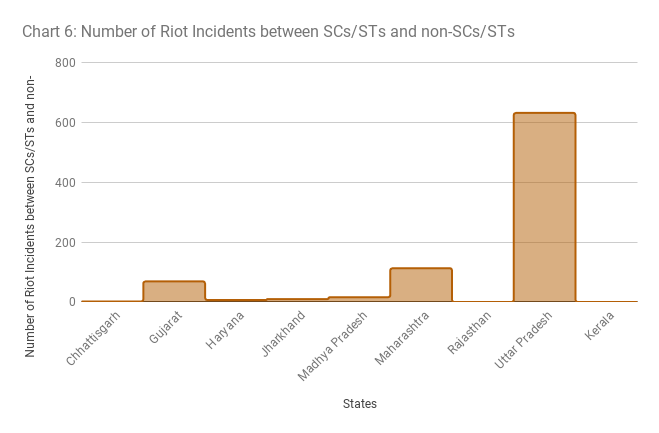
Most BJP-ruled States had an alarmingly high number of dowry deaths (Chart 7). The numbers were 89 in Chattisgarh, 243 in Haryana, 463 in Rajasthan, and 664 in Madhya Pradesh. Once again, Uttar Pradesh had even higher numbers, at 2335. Kerala had 8 reported dowry deaths in the year under consideration.
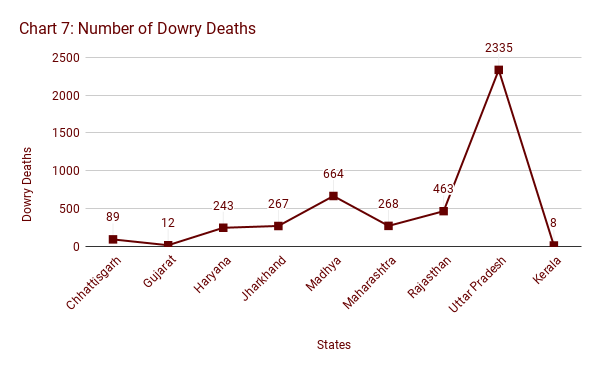
In spite of all these, NCRB numbers show that the overall rate of “IPC crimes against body” is the highest in Kerala. The reason – a very high rate of reporting/registration of crimes. In fact the bulk of such IPC crimes in Kerala, i.e., 1,30,907 out of a total of 1,39,562 – are accounted for by one single offence – “causing injuries under rash driving/road rage”. A large number of cases recorded as “attempt to commit culpable homicide” are also recorded in the state, many of which are also associated with traffic-related incidents.
Observers and legal experts note that such high rates of registration of cases in the State is because of relatively higher legal awareness among the populace, and due to police being comparatively more pro-active in registering cases. This is in stark contrast to the pattern elsewhere, including in the national capital Delhi, where the police is hesitant to register the bulk of traffic-related cases. An interesting explanation about the high reported crime rate in Kerala compared to absurdly low rates in some other States was given by Jacob Punnoose, former DGP of Kerala in an episode of the TV show SatyamevJayate, Season 2 (2014). Watch it here:
Kerala also has the highest conviction rate among bigger states - 82.3%, and the second highest conviction rate among all states, behind Mizoram (93.8%). The conviction rate is a barometer for the effectiveness of the criminal justice system, and measures the proportion of cases which have resulted in conviction compared to cases in which trials were completed. Tamil Nadu, which is placed second among the bigger states, has a 69.6% conviction rate.
While Kerala has very low numbers of communal and caste riots, it has the highest numbers of cases recorded as “political riots” and “student riots”. The reason is this. Kerala, , with its vibrant political society (including powerful student movements), witnesses a large number of protests on a large number of issues every year. In fact political mobilisation by mass organisations have been the key driving force behind the achievements in the human development front that Kerala has been known for. Protesters coming into some sort of clash with the police is very common, and even minor tussles are recorded and classified as “political riots” (or in the case of student protests, “student riots”).
The pattern of low rates of crimes such as murder, kidnapping & abduction, communal riots, caste riots etc. in Kerala coinciding with high rates of traffic-related offences and “political riots” lead us to two important conclusions regarding the State. One, criminal elements seem to be relatively under control, reflected in low rates of violent crimes. And two, people in the State frequently come together and hit the streets in order to advance their rights.
In short, Kerala is without doubt among the most peaceful States in India. The SanghParivar propaganda about the State falls flat in the face of facts.
Disclaimer: The views expressed here are the author's personal views, and do not necessarily represent the views of Newsclick.
Get the latest reports & analysis with people's perspective on Protests, movements & deep analytical videos, discussions of the current affairs in your Telegram app. Subscribe to NewsClick's Telegram channel & get Real-Time updates on stories, as they get published on our website.














